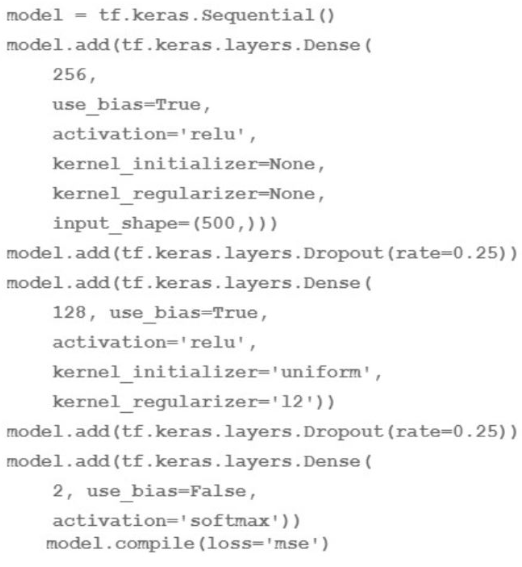Google Professional-Machine-Learning-Engineer - Google Professional Machine Learning Engineer
Total 285 questions
You are going to train a DNN regression model with Keras APIs using this code:

How many trainable weights does your model have? (The arithmetic below is correct.)
You have built a custom model that performs several memory-intensive preprocessing tasks before it makes a prediction. You deployed the model to a Vertex Al endpoint. and validated that results were received in a reasonable amount of time After routing user traffic to the endpoint, you discover that the endpoint does not autoscale as expected when receiving multiple requests What should you do?
You work on a growing team of more than 50 data scientists who all use Al Platform. You are designing a strategy to organize your jobs, models, and versions in a clean and scalable way. Which strategy should you choose?
You have a custom job that runs on Vertex Al on a weekly basis The job is Implemented using a proprietary ML workflow that produces the datasets. models, and custom artifacts, and sends them to a Cloud Storage bucket Many different versions of the datasets and models were created Due to compliance requirements, your company needs to track which model was used for making a particular prediction, and needs access to the artifacts for each model. How should you configure your workflows to meet these requirement?
You work on the data science team at a manufacturing company. You are reviewing the company's historical sales data, which has hundreds of millions of records. For your exploratory data analysis, you need to calculate descriptive statistics such as mean, median, and mode; conduct complex statistical tests for hypothesis testing; and plot variations of the features over time You want to use as much of the sales data as possible in your analyses while minimizing computational resources. What should you do?
You built a deep learning-based image classification model by using on-premises data. You want to use Vertex Al to deploy the model to production Due to security concerns you cannot move your data to the cloud. You are aware that the input data distribution might change over time You need to detect model performance changes in production. What should you do?
You are developing an ML model intended to classify whether X-Ray images indicate bone fracture risk. You have trained on Api Resnet architecture on Vertex AI using a TPU as an accelerator, however you are unsatisfied with the trainning time and use memory usage. You want to quickly iterate your training code but make minimal changes to the code. You also want to minimize impact on the models accuracy. What should you do?
You have been asked to productionize a proof-of-concept ML model built using Keras. The model was trained in a Jupyter notebook on a data scientist’s local machine. The notebook contains a cell that performs data validation and a cell that performs model analysis. You need to orchestrate the steps contained in the notebook and automate the execution of these steps for weekly retraining. You expect much more training data in the future. You want your solution to take advantage of managed services while minimizing cost. What should you do?
You recently deployed a scikit-learn model to a Vertex Al endpoint You are now testing the model on live production traffic While monitoring the endpoint. you discover twice as many requests per hour than expected throughout the day You want the endpoint to efficiently scale when the demand increases in the future to prevent users from experiencing high latency What should you do?
You work with a team of researchers to develop state-of-the-art algorithms for financial analysis. Your team develops and debugs complex models in TensorFlow. You want to maintain the ease of debugging while also reducing the model training time. How should you set up your training environment?



